Advice & Tips
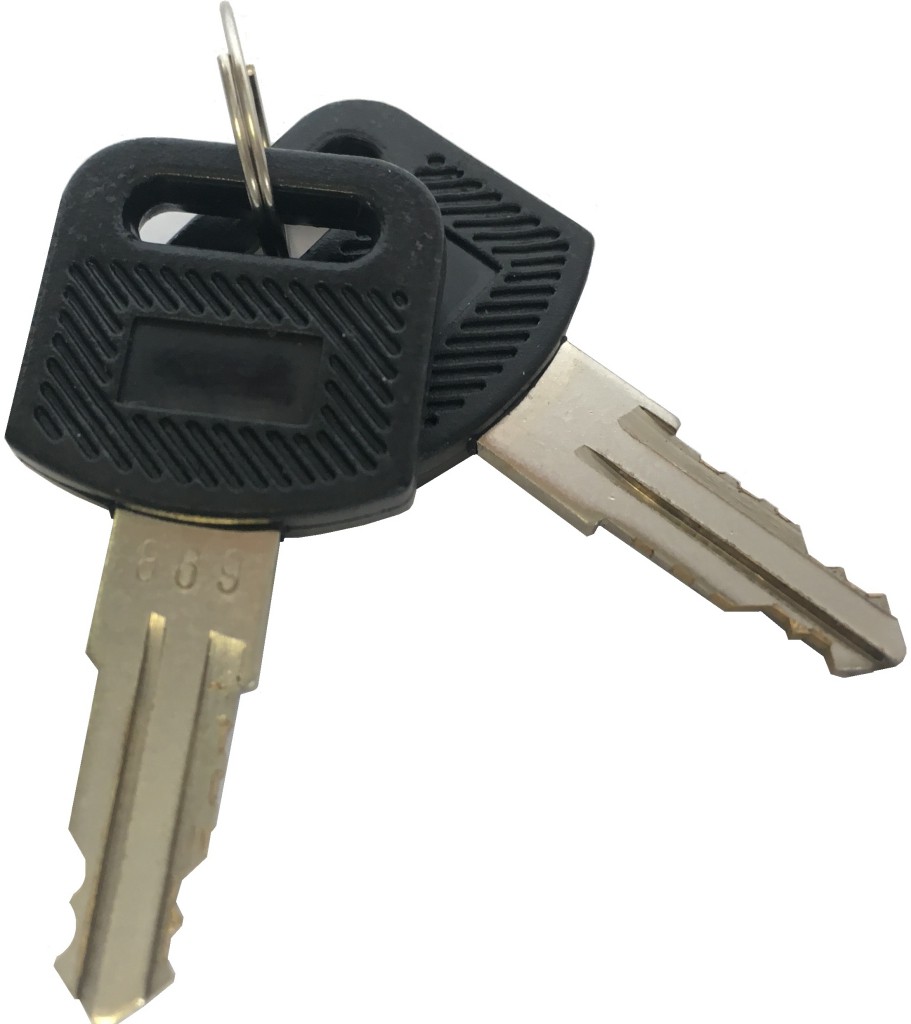
We often get asked about the replacement of lost keys or supply of additional keys. We can only provide replacement keys for a small selection of manufacturers and if you have purchased the safe from us.
Extra and replacement keys for elsewhere bought safes
If you have purchased a safe from a different retailer such as B&Q, Screwfix, Homebase or other DIY chains then we are not able to assist you and you would need to contact a local locksmith to have them pick the lock or drill it open.
Extra and replacement keys for our safes
If your safe is one that we stock we may be able to help. We will try to source the keys from the manufacturer as we do not hold stock of spare keys or blanks.
The average high street key cutting shop will not be able to provide you with suitable replacement keys for your safe. To locate a reputable locksmith we recommend you visit www.locksmiths.co.uk and search your local postcode for safe services.
Emergency codes for electronic safes
A large proportion of our electronic safes come with an emergency backup key to gain access to a safe when the batteries have expired or if you have simply forgotten the code. These are often tubular in shape.
We can also provide hotel safes with an emergency override key that will open a number of electronic safes when you order batches of the same safe to be used within hotel rooms. Please contact us for a quotation should you require this service.

Not all safes on the market are fireproof. Most safes do not offer any fire protection at all, so it is important to check the safe you are purchasing gives you the protection you require.
When purchasing a fire safe it is important to choose the right safe for whatever it is you are planning to store within it. Different types offer differing protection levels, so to ensure you are protected there are a few simple rules to follow.
Fireproof safes for paper documents
If the items you want to store are paper documents such as wills, passports and other paperwork you should choose a safe that is listed with fire protection for paper/documents. These have protection levels that start at around 30 minutes fire resistance and can go all the way up to 120 minutes protection.
Fireproof safes for digital media
The protection of digital media, hard drives and data from fire, requires a very different type of fire safe. In this instance choose a safe that is listed as a fire safe for digital media or data (different types of data storage require different safes). Fire safes for data tend to have thicker walling and are generally much heavier than a fire safe for paper/documents due to the need to protect the items within from heat.
Anchoring a fireproof safe
Fire safes in general are usually bolted through the base into a concrete floor and tend to be heavier than a traditional security safe. It is important that they are fitted according to manufacturer’s instructions to ensure that the proper protection is being given to the items within.
Choosing the right safe
There is no fire test for belongings such as jewellery, watches, cameras or other similar items so when looking for a safe for these items alone, choose a safe with good security as its primary function. If you are looking to put paper items within a safe that also contains these items, look for an AiS Approved safe that is provided with 30 minutes fire resistance for paper/documents. In this instance you will be getting the security you need, combined with the piece of mind of some fire protection for your paper documents.
Finally, always check with your insurance provider when purchasing a safe and seek professional advice if unsure of your needs.
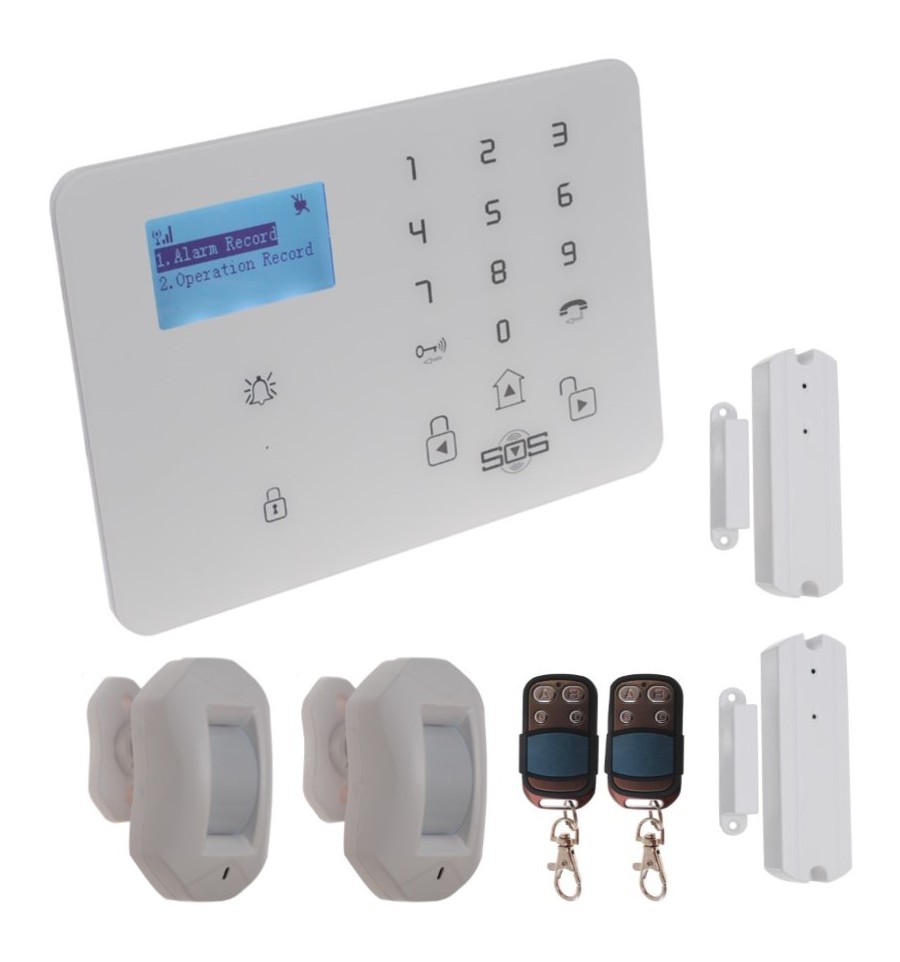
Alarm systems are usually purchased as a result of a burglary or burglaries in your area. There is a wide choice of home security options available. This buying guide is to help you make an informed decision as to which type would suit you best.
At Simply Safes, we understand there are a lot of companies who will sell and install an alarm for you. In our experience, these companies often charge a subscription fee and will try to sign you into a maintenance contract. We have even heard of customers being charged for a call out to fix an alarm with a fault.
Our alarms are DIY friendly and have no monthly fees attached to them. We can even arrange a professional alarm installer for you if required, for added peace of mind.
Should I get a wired or wireless solution?
Wired alarms used to be the only option if you wanted a burglar alarm system. Technology has moved on considerably meaning you now do not need to run wires to all parts of your home. Our range of DIY alarms are all wireless alarms are easy to install. Some models have a smartphone app, which means you can control your alarm and receive notifications. Others just connect to your landline and are ideal for the older generation or those who do not have a good mobile signal.
It is a common misconception that customers worry about a wireless system being hacked. All the sensors use a unique ID to communicate with each other. These are the length of 4 mobile telephone numbers.
Shall I choose a smart alarm or another option?
If you opt for a smart alarm, this will connect with your Wi-Fi at home. It will also have the benefit of over the air updates as and when new features are introduced. Choosing a smart alarm might not be the best solution for everyone, so the alternative types of alarms are:
- Telecommunicating alarm - which will use your landline to alert you
- Dual communicating alarm - which you plug into a landline and also fit a SIM card
You can also fit a SIM card as a backup method into all our smart alarms. Ultimately your choice will hinge on how reliable the Wi-Fi is at your property and the mobile phone signal in your area.
Can I get notifications sent to my mobile phone?
Most models will send push notifications to your smartphone. The only alarm systems that will not do this is the telecommunicating versions. These are connected only to your landline so they will call you in the event a sensor is triggered while the alarm is armed. If you have a SIM only or dual communicating alarm, you must ensure that you have credit to receive the notifications.
Mobile phone signal in my area is not good, what are my options?
If you do not have a good mobile signal at your property, we would suggest you consider a system that uses a landline. This is more likely to give you better reliability of alerts.
Another alternative is to choose a smart alarm that connects to your Wi-Fi. In this instance you would not receive alerts in the event your broadband is not working.
The walls in my property are quite thick or have foil for insulation, will this cause a problem?
If you have thick walls, foil insulation or have several walls on the route to different sensors then you have a couple of options. In this instance you could choose an alarm system that has a range extender sensor in it, this will boost the signal quite significantly.
You may however, have to opt for a wired solution to prevent issues such as a sensor not alerting you at all or delays in the alert.
What other accessories would make my system better all round?
Typically home alarm systems used to just feature a door/window sensor and PIR motion detectors. As technology has advanced, other useful sensors have been introduced to offer you greater peace of mind. These include a smoke alarm to alert you in the event of a fire and a water detector. We at Simply Safes feel a water sensor is very useful as they can be placed in various locations such as behind a washing machine, under a sink or in a boiler cupboard. This will give you more advanced warning of a leak that could save you potentially thousands of pounds of money in damages.
I live in an apartment, am I allowed to put a siren box outside?
By law, if you own a flat or apartment then you are not allowed to place a siren intruder alarm outside. All our alarms feature control panels that internal sirens, on most of these models you can adjust the volume.
All the sensors in the kit look quite tricky, how difficult are they to install?
Usually in an entry level alarm kit you will find there are the following sensors:
- Door or window sensor
- PIR motion sensor
- Siren box
These are all fairly straightforward to install if you are competent at DIY. To install a door or window sensor is really easy. There is 3M sticky tape on the rear which you peel off and fit. The motion sensor can also be secured with 3M adhesive tape, however it is best secured to a wall using the bracket supplied. This is a fairly simple process of drilling two holes and using the screws and rawl plugs included. Perhaps the most tricky sensor from the list is a siren box because you will need a ladder and a head for heights to secure it to the outside of your property. Other than that, you're one step closer to having a secure smart home.
I live in a large property and want to also protect an outbuilding, is this possible?
To help you protect your property you can add up to 50 sensors on most of the alarms that we sell. This gives you complete flexibility to customise the system around your needs. If you have a garden shed or outbuilding such as a barn then you may require a range extender sensor. This will boost the signal to 300 metres and is available with selected ranges.
Will the motion sensors work at night and will they detect pets?
Yes, sensors are designed to work in all kinds of light and are primarily there to detect movement. Some motion sensors are pet friendly up to 25kg which is a cocker spaniel size, but not all ranges are so ensure you check this before purchasing.
Can I subscribe to Police response?
Our range of DIY alarms can not be connected to a monitoring service, should you require this type of alarm you will need to have a professional range that is installed by a registered alarm engineer. This will of course be reflected in the cost and you might be limited in functionality compared to the DIY range we offer.
Will the alarm system link to a video doorbell?
The ERA Homeguard Pro alarm kits and the ERA Doorcam will eventually be under one smartphone app, currently they are separate. ERA also have an internal wireless camera that is integrated into the Homeguard app.
Our summary
As with most products, the kind of alarm system that will suit one customer might not suit another. Rest assured though, that we have a system to help you protect your home better.
We hope that this buying guide has helped you to understand the types of alarms that are available on the market better and how you can add additional sensors to suit your property.
Should you require any further assistance to help you make a choice then please do not hesitate to contact one of our friendly sales team.
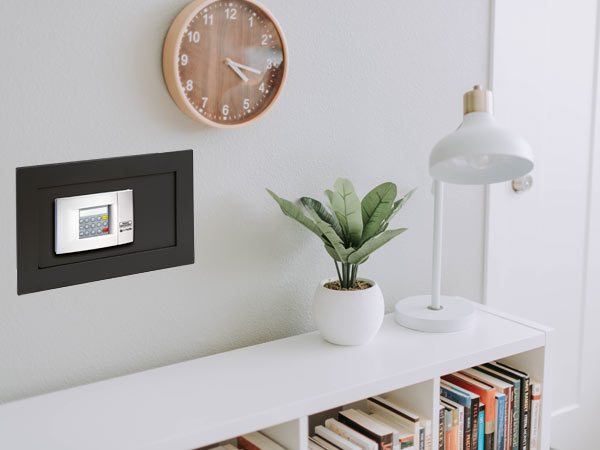
Wall safes are specifically designed to be secured within a cut out section in a wall as opposed to a standard type safe which you bolt to a wall or floor and this is a free standing type of safe.
Whether a wall safe is suitable to be installed in your home would be determined by the type of walling you have within your property. Firstly, a wall safe needs to be cut into a brick, block or masonry wall and concreted in, so you need to have a suitable site within your property to place the safe. A good site is a brick chimney breast which gives plenty of space.
Good insulation
Good insulation is also necessary. Because exterior/internal brick walls can ‘breathe’, condensation can build up around the safe which can cause damage to locking mechanisms over a long period of time and can get inside the safe damaging items within. To avoid this happening, adding additional insulation or a waterproof membrane around the safe prior to the concrete being added is a good idea. It is then advisable to allow the site to settle for 7 days prior to first use while any moisture from the concrete dissipates.
Secure space to lock away your valuables
Once installed and settled, a wall safe provides a good, secure space to lock away your valuable items and documents, hidden from view behind a photo, picture or even a ‘false’ front. Some people prefer the ‘hidden’ nature of a wall safe, however having a safe installed into a wall does not give you any greater insurance cover and as with any safe it is important to check with your insurance company that your policy covers items placed within it in the event of theft.
Finally, as wall safes can be more involved to install, it is worth seeking professional advice prior to purchase.
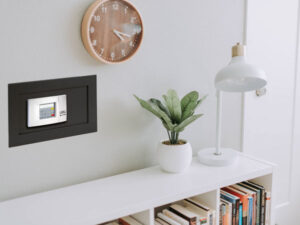

Here at Simply Safes, this is one of the most frequently asked questions that we receive. We have put together this handy buying guide to help you make your choice. Ultimately it is our opinion that this broadly down to your own personal preference. This guide also goes into further detail about the different options available on digital locks and your options when faced with a really long safe key.
How secure is a digital lock and can it be hacked? 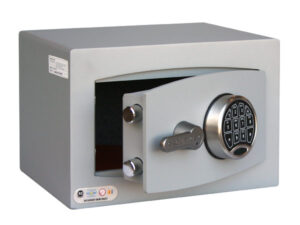
When a safe is tested for insurance purposes, it is done in two parts, one is the safe and the other is the lock. The lock goes through testing and part of that is to check if it can be hacked by various methods.
Of course the lock is only as secure as the numbers that are programmed into it and ensuring all factory codes are changed. The last thing you want is not have deleted a master code that is readily available in product manuals online.
We also recommend that you ensure the code is changed regularly and to use different numbers in that process to avoid tell signs of keypad wear that might tip off an opportunist.
Is one lock type more secure than another?
Essentially, no one type of lock is more secure than another, as we have mentioned above. Locks are tested to a specific level for the type of safe it is fitted too.
Ultimately it boils down to keeping the code you set secure on a digital lock or keeping the key secure. For insurance purposes, your broker can insist you keep the key on your person at all times.
What happens if the batteries fail on my digital lock?
Is it some customers fear that if the batteries fail then the safe might spring open or go back to the default settings. Rest assured, it will definitely not just open and only in very rare cases will it go back to the default factory codes if at all.
In essence, we strongly recommend that you ensure you change the batteries regularly to avoid these kinds on issues. It might be wise to put a simple calendar reminder in for 6 months after your purchase to check the level of the batteries.
What happens if I lose a key to my safe?
If you should lose a key to an entry level model, then sadly it is not possible to get replacements in most cases. You could try a locksmith local to you, this needs to be a reputable MLA registered locksmith and not somewhere such as Timpsons. If you have purchased an Arregui or BTV safe from us then it may be possible for us to arrange a replacement key however we need proof of purchase and a form of ID before we are able to do this.
Should you lose a key to an insurance approved model with a double bitted key lock then replacements can be cut for you but a copy would need to be made from an original. If you have lost both keys we can arrange for an engineer to visit, they would use best practice to minimise any damages. Once open, a new lock can be fitted to get your belongings secure again.
Some key locking models from Burg Wachter and De Raat Security have the option to re-key your lock. This means should you lose a key or a staff member leaves with one, the safe is not compromised. As long as you have one key to open the lock, you can change the lock over to a new set of keys.
To do this, you would need to purchase a set of new keys in a kit from us - in the kit also comes a change key. All of this can be done without the need to call a locksmith out, saving you money. Please call us for more details and assistance.
What are my options on the really long safe keys?
If you have a higher rated safe that features long safe keys, which you do not want to keep on your person then in some cases it is possible to have key stem system. This is where the keys come in multiple parts and essentially you put the key together to open the lock.
The only part you would need to keep on your person in this instance is the part that features the double bitted key.
I need an audit trail and multiple users, is this possible?
Yes this is certainly no issue at all, you may require a more advanced digital lock to be fitted, if you require certain functionality. Where possible, we will find a product that matches your requirements from an off the shelf item.
This will be more cost effective for you and also quicker to be delivered. Please call one of our friendly sales team to discuss your options further
Are you able to provide digital locks with one-time access codes?
We have worked with several large customers on big projects where very advanced digital locks were required. This was for audit and internal purposes to provide added security for staff members. One-time access codes can be created off-site and then sent to the user that is present, once they have been verified.
Our summary
We hope you have found this buying guide to be helpful, we understand that some of the tips may not apply to everyone.
In short, keys for safes that are approved for insurance purposes may need to kept on your person, so could prove an inconvenience. There is however, peace of mind in that you do not have to remember a code or change batteries.
An electronic digital lock has the benefit of no keys to keep with you and are easy to open for the user. The more advanced locks have various features which might be of more benefit to the commercial market.

Positioning and securing a safe yourself is possible with the right knowledge and tools . The lighter safes in particular are not that difficult to position and bolt down yourself.
Read on for supplies and step-by-step instructions.
Supplies needed to install a safe yourself
- Impact drill
- Concrete drill
- Socket wrench
- Plastic hammer
- Level
- Air syringe
- Fixing anchors (with or without delivery with safe)
Secure your safe in 7 steps
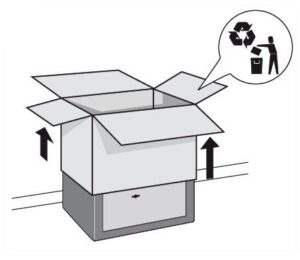
1. Take the safe out of the packaging and dispose of the packaging material in an environmentally friendly manner.
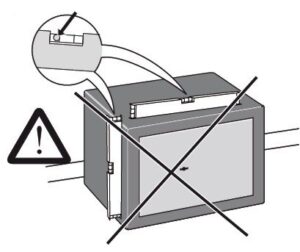
2. Place the safe in the desired location. Check that the safe is level and if it has enough room for the door to fully open. Remove any flooring elements so the safe is placed directly on the concrete.
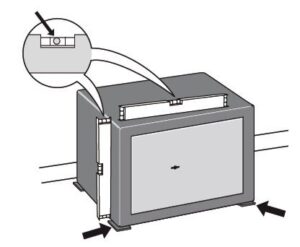
3. If necessary, fill the space under the safe until it is level.
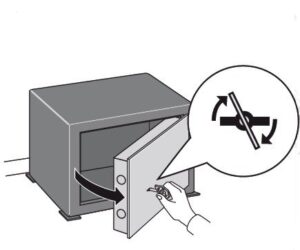
4. Insert the key or operate the electronic lock and open the safe.
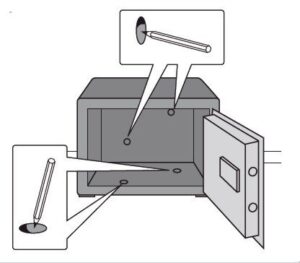
5. Mark the anchor holes on the floor with a pencil. Depending on the safe 1 or more holes.
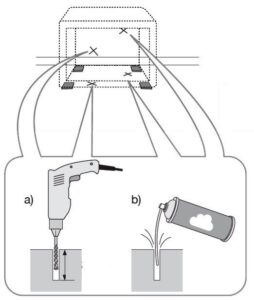
6. Drill the marked holes. Depending on the size of the safe, the safe will first be removed to drill the holes. Make sure the holes are free of grit.
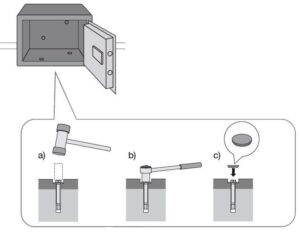
7. Postion the safe on the mounting holes and follow the final steps.
- Place the anchors through the inside of the safe in the pre-drilled mounting holes.
- Drive the fixing anchors completely into the holes using the plastic hammer.
- Tighten the bolts using the socket wrench.
- If supplied: place the cover over the hole.
Tips & tricks for placing and fixing a safe
- Always make sure that there are no pipes in the wall or floor in which you want to drill. Drilling is not possible with underfloor heating. Use a pipe finder to be on the safe side.
- It is necessary to use the correct drill diameter for maximum strength.
- Adjust the mounting anchors to the type of floor or wall to which you want to attach the safe.
- Positioning a safe is specialist work. It is particularly difficult to maneuver with heavy safes. Always ensure a safe working environment.
- Always have a flat floor and wall; make sure that there are no crevices or cracks, so that a crowbar can easily get 'grip'.
- Remove the existing plinth to get a good connection between the back of the safe and the wall against which it is placed.
- Make sure you have the correct tightening torque with the anchors and used screws.
- Close or operate the lock with open safe door. This way you can check whether the closing mechanism is functioning properly.
Have the safe installed and secured by Simplysafes.co.uk?
Perhaps you prefer to have the safe installed and secured by experienced and skilled technicians. We are happy to be of service. We have a professional and experienced installation service with years of experience and know which measures must be taken to place and anchor a (heavy) safe safely, correctly and in the desired location. If you want a standard installation and fixing, you can select it directly at the product page when you place it in the shopping cart. A standard installation is delivery, positioning and anchoring on the ground floor or on a floor with an elevator. There are no thresholds at the 1st door or front door and the route to the place where the safe should be located is flat.
For more information go to the installation page or contact us directly for placements under special circumstances, such as in a basement, on a floor without an elevator, etc.